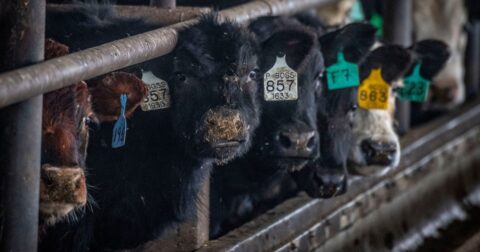Explainer
Why Eating Organic Isn’t a Climate Solution
Climate•8 min read
Solutions
A new report signed by 200 climate researchers says we have the next decade to reduce emissions from factory farms, and most within five years.


Words by Marlena Williams
The climate movement has long shied away from acknowledging the role meat and dairy play in fueling climate change. For years, the discussion largely centered around fossil fuels, and how transportation and the energy sector drive global warming, while the massive impact of the livestock industry was largely pushed to the margins of the conversation. Now, a report from the Animal Law & Policy Program at Harvard Law School includes a stark warning: the planet needs to make rapid and significant reductions in livestock-related emissions in the next decade — most within the next five years — in order to avoid driving global temperatures past 1.5 ° Celsius by 2030.
Despite the fact that meat and dairy are a major contributor to greenhouse gas emissions, environmentalists and policymakers have dodged the issue for decades, and 93 percent of climate news stories never mention meat at all. Many lawmakers, climate activists and the public as a whole still aren’t making the crucial connection between meat and climate change, even as nations continue to lag behind on key climate goals.
The new report surveyed over 200 experts based in 48 countries, a mix of climate scientists and sustainable agriculture researchers, the vast majority of whom agree that dramatically decreasing the consumption and production of meat is crucial to the Paris Agreement goal of limiting global warming to 1.5° Celsius by 2030. According to Harvard’s Animal Law Program, the report is the first of its kind to show a clear consensus among experts that reducing the production and consumption of meat must be a key element of any climate change strategy moving forward.
“The report brings into sharp focus just how deep and rapid the changes to the livestock sector must be,” says Dr. Helen Harwatt, a Food & Climate Policy Fellow at Harvard Law School and one of the co-authors of the report. “We now know that major changes are needed over the next ten or so years, and mostly in the next five. This makes it an issue for today rather than tomorrow, and for current policy planning rather than the next political cycle, or the one after that.”
Just over five years remain for the world to meet the goals of the Paris Agreement, an agreement that emerged from COP21, the UN’s global climate change conference held in Paris in 2015. And yet, out of 175 signatories, only 12 have pledged to reduce greenhouse gas emissions from their meat and dairy sectors. Even though demand for fossil fuels and energy-related carbon dioxide emissions is predicted to drop by the middle of this decade, meat production and consumption continues to climb upwards globally.
The global food system is staggering, both in terms of scale and environmental impact. An estimated 92.2 billion animals are slaughtered each year for food. Across the world, about 1.5 billion cows are raised for their meat alone, and remain the largest contributor to anthropogenic methane emissions, mostly from burps as they digest their food. A 2021 study suggests that global greenhouse gas emissions from animal agriculture are twice those of plant-based foods.
Raising, feeding, killing and transporting such a huge number of animals has a devastating environmental impact. The global food system accounts for about 33 percent of global greenhouse gas emissions, with the livestock sector responsible for a massive share of all food-related emissions at a whopping 57 percent.
What’s more, since methane has a much shorter lifespan compared to carbon dioxide (CO2) and nitrous oxide (N2O), some climate models suggest a strategy of tackling methane emissions in the short term, and meat is a prime target. Though methane is far more potent than carbon dioxide, it only remains in the atmosphere for about 12 years before degrading — as opposed to carbon dioxide, which can stay trapped in the atmosphere for centuries. In other words, curbing methane (including by eating less meat) is an effective way to curb climate pollution in the short and medium term, essentially “buying time” for more dramatic and lasting reductions in other sectors.
Of the 200 experts surveyed for the Harvard report, 92 percent agree that reducing emissions from the livestock sector is essential to keeping temperature rise to a maximum of 2° Celsius above pre-industrial levels. “Without substantial reductions,” says the report, “greenhouse emissions from the global food system alone would make 1.5 degrees Celsius an impossible temperature limit.”
There are a number of ways to curb emissions from the food system — and each comes with its own set of tradeoffs. Eighty-five percent of the experts surveyed by Harvard agreed that human diets must rapidly shift away from meat and towards plant-based foods. That’s because curbing meat and dairy consumption, and reducing the number of animals farmed overall, are the most effective ways to reduce food-related greenhouse gas emissions, according to the report.
Still, there are other solutions. Transitioning from methane-intensive cattle to animals that are far lower in emissions, like chickens, would also help curb overall greenhouse gas emissions, though plants like legumes are even more of a win for emissions savings. Many policymakers and meat industry groups have suggested investing in methane-reducing technology, improving harmful manure management practices and farming a larger number of animals more intensively. But because all of these strategies offer a more modest emissions drawdown than dietary change and come with significant drawbacks — including increased animal suffering, threats to public health from zoonotic disease outbreaks and continued water and soil pollution — the experts surveyed by Harvard endorse a wider societal shift towards plant-forward diets.
Of course, dietary change comes with its own set of unique challenges — convincing people to give up the foods they love is in and of itself a hugely difficult task — but the time to experiment with less effective solutions has passed, the authors of the Harvard report warn, especially when we know that a shift to plant-based diets can help put the world back on the right track to limit global warming.
Another major reason to endorse plant-forward food systems is the role meat and dairy play in fueling deforestation. Transitioning land currently used for livestock grazing back to its native vegetation could remove the equivalent of 16 years of current global carbon dioxide emissions from the atmosphere over a 30 year period.
Almost half of all habitable land — 44 percent — is used for agriculture, including pasture and land used for growing crops like corn and soybeans that go straight into animal feed. This system is remarkably inefficient, even when it comes to high-efficiency factory farms. It takes 25 kg of feed crops to produce just 1 kg of beef, for instance. On the other hand, if the same area of land were optimized for plant-based food production, we would be able to feed twice as many people, about 350 million.
The bottom line: countries can no longer afford to ignore the serious climate impact of meat and dairy. Reaching the global reductions targets set out in the Paris Climate Agreement will require the global north to dramatically reduce production and consumption of these foods in the next five years. While achieving such massive reductions so quickly can feel daunting, shifting to plant-forward diets and reimagining global land use provide two clear and articulable paths forward.
Meat remains a sensitive subject for policymakers, yet the time for action is quickly running out. If we do not reckon quickly and decisively with the significant role animal agriculture plays in driving climate change, researchers warn all other emissions reductions plans may be for nought.